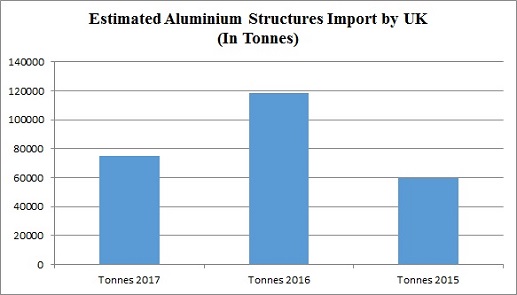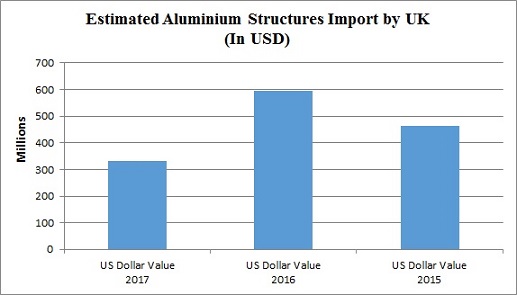

The building and construction sector in the United Kingdom expanded at its fastest rate in past 17 months in May, driven by a dramatic rebound in homebuilding after a slow start to 2017, a latest survey report says. The Markit/CIPS construction purchasing managers' index rose to 56 from 53.1, the highest since December 2015 (Note: A figure above 50 indicates expansion). Boosted by this growth, the UK’s import of aluminium structures and aluminium cladding is also rising. The imports grew at per cent rate year-over-year in 2016.
The UK imported 118,302 tonnes of aluminium structures in 2016. The imports included housing construction components like aluminium roofing, aluminium cladding, and structures made of extruded aluminium products. The total cost of imports stood at US$596 million vis-à-vis US$464 million in 2015.
{alcircleadd}
Owing to the increased construction of commercial as well as residential buildings and towers in prime hubs of London, import of aluminium structures and cladding will increase in 2017, suggests yearly trade data. The total import of aluminium structures and cladding (till October) will reach an estimated 74844 tonnes by this year end, and will be valued at US$331 million.

Of late, aluminium structures and cladding have been in the news for all the wrong reasons. Multiple fire incidents were reported in London and Dubai (2015) associating the use of flammable aluminium cladding with thermoplastic core. However, with the increased fire safety awareness among end users, manufacturers and builders are shifting more to non-combustible varieties of PVDF coated aluminium composite panels or aluminium cladding. These cladding components will help lower the rates of fire incidents worldwide.
{googleAdsense}
The UK have been importing aluminium structures mainly from the European countries like Italy (7133 tonnes in 2016), France and Germany apart from China (11786 tonnes). The country will continue to import from these regions in 2017 as well.
"A sustained rebound in residential building provides an encouraging sign that the recent a soft patch for property values has not deterred new housing supply," said Tim Moore, senior economist at IHS Markit.
"Instead, strong labour market conditions, resilient demand and ultra-low mortgage rates appear to have helped boost work on residential development projects," he said.



Responses






